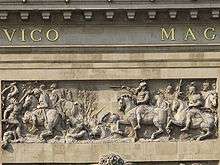History of crossings of the Rhine
.jpg)
The crossing of the Rhine at Tolhuis (now a suburb of Nijmegen) on 12 June 1672 - painting by Adam Frans van der Meulen.

A 'passage of the Rhine' on the south facade of the porte Saint-Denis.
The River Rhine forms a natural frontier and so the phrase Rhine Crossing or Crossing of the Rhine may refer to one of several crossings of it:
- the Crossing of the Rhine from east to west by barbarians in 406, into the territory of the Roman Empire
- several times by French troops invading Germany during the Franco-Dutch War, such as:
- 12 June 1672 near Tolhuis, commanded by the Vicomte de Turenne and Louis, Prince of Condé, in which Louis was severely wounded forcing the river crossing - this crossing was commemorated in the painting Crossing of the Rhine by the army of Louis XIV, 1672 by Joseph Parrocel
- 1673, led by Turenne
- several times by French troops invading Germany during the French Revolutionary Wars:
- for the first time in 1794, near Düsseldorf
- on 6 September 1795, as commemorated in Louis-François Lejeune's painting First crossing of the Rhine by the French army commander by Jourdan and Kléber, at Düsseldorf in the duchy of Berg, 6 September 1795
- 18 April 1797, by French Revolutionary forces near Neuwied, causing to the Battle of Neuwied.
- Between 27 April and 2 May 1800, 100,000 men under Jean Victor Marie Moreau, crossing to confront the Austrians, who they then met at the battle of Stockach.
- the crossing from west to east by the western Allies in March 1945 during the Western Allied invasion of Germany, including Operation Plunder and Operation Varsity - British units participating were granted the battle honour 'Rhine Crossing' by the British Army
This article is issued from
Wikipedia.
The text is licensed under Creative Commons - Attribution - Sharealike.
Additional terms may apply for the media files.